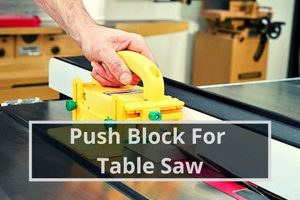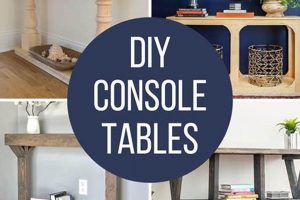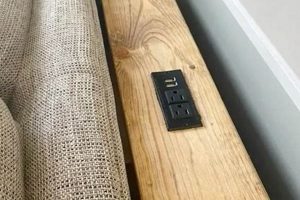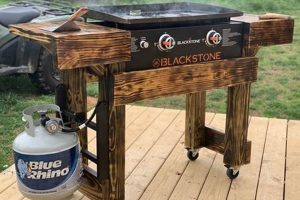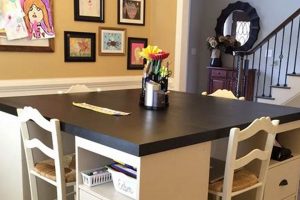Rejuvenating a laminate-surfaced table, commonly known as Formica, using do-it-yourself methods entails restoring the aesthetic appeal and functionality of the furniture without professional assistance. This process addresses common issues such as scratches, stains, and general wear, improving the overall appearance and extending the lifespan of the table. An example would involve addressing a water ring stain using household cleaning agents and gentle abrasion techniques.
Undertaking the restoration of a Formica tabletop yields several advantages. It represents a cost-effective alternative to replacing the entire table, conserving resources and minimizing environmental impact. Furthermore, it allows for personalization, enabling homeowners to tailor the table’s appearance to match their existing decor. The practice of refurbishing furniture has historical roots in periods of economic constraint and resourcefulness, showcasing a commitment to sustainability and reducing waste.
The subsequent discussion will detail various techniques for cleaning, repairing, and refinishing Formica tabletops. Emphasis will be placed on appropriate material selection, safe work practices, and effective methods for achieving a professional-looking result. The information presented aims to equip individuals with the knowledge necessary to successfully restore their Formica-topped tables.
Formica Tabletop Restoration
The following guidance presents key considerations for restoring Formica-surfaced tables. Adherence to these points can optimize the outcome and longevity of the restoration project.
Tip 1: Thorough Cleaning is Paramount: Prior to any repair or refinishing, a comprehensive cleaning is essential. Employ a mild detergent solution and a non-abrasive cloth to remove all surface contaminants. Failure to adequately clean the surface can impede adhesion of repair materials or finishes.
Tip 2: Identify and Address Underlying Issues: Assess the table for any structural damage, such as loose supports or wobbly legs. Repair these issues before addressing the Formica surface itself. A stable base is crucial for a successful restoration.
Tip 3: Conceal Scratches Effectively: Minor surface scratches can often be concealed with specialized laminate repair pastes or crayons matched to the Formica’s color. Apply the product according to the manufacturer’s instructions, ensuring a seamless blend with the surrounding surface.
Tip 4: Address Stubborn Stains Strategically: Persistent stains may require targeted treatment. A paste of baking soda and water can be effective for some stains. In more severe cases, consider using a laminate-specific stain remover, following safety precautions and product instructions.
Tip 5: Exercise Caution with Abrasives: Avoid harsh abrasive cleaners or scrubbing pads, as they can damage the Formica surface. If light abrasion is necessary, use ultra-fine grit sandpaper (e.g., 600-grit or higher) and proceed with extreme caution.
Tip 6: Consider a Protective Finish: After cleaning or repairs, applying a clear protective coating designed for laminate surfaces can enhance durability and resistance to future damage. Ensure compatibility with the existing Formica and follow the manufacturer’s application guidelines.
Tip 7: Test Products in an Inconspicuous Area: Before applying any cleaning agents, repair compounds, or finishes to the entire tabletop, test them in a small, hidden area to ensure compatibility and prevent unintended damage or discoloration.
Successfully rejuvenating a Formica-topped table hinges on meticulous preparation, appropriate material selection, and careful execution. By adhering to these guidelines, individuals can effectively restore their tables, prolonging their use and enhancing their aesthetic value.
The next section will discuss advanced techniques for heavily damaged surfaces and professional finish applications.
1. Surface Preparation
The success of rejuvenating a Formica-topped table hinges critically on meticulous surface preparation. This stage directly impacts the adhesion of repair materials, the effectiveness of stain removal techniques, and the overall finish quality. Inadequate surface preparation invariably leads to premature failure of the restoration effort, manifesting as peeling finishes, visible imperfections, or compromised structural integrity. For example, if residual grease or wax remains on the Formica surface prior to applying a repair filler, the filler will likely not bond correctly, resulting in cracking or detachment over time.
A comprehensive surface preparation regimen involves several essential steps. First, the table should be thoroughly cleaned with a degreasing agent to eliminate any traces of grease, oil, or wax. This may necessitate multiple cleaning passes, depending on the table’s condition. Following degreasing, a mild abrasive cleaner can be used to lightly etch the Formica surface, creating a mechanical key for subsequent coatings or repairs. This step must be performed with care to avoid damaging the underlying laminate. Finally, the surface should be meticulously rinsed and dried to remove any residual cleaning agents, as their presence can interfere with the adhesion of repair materials.
In conclusion, surface preparation is not merely a preliminary step but an integral component of the entire restoration process. Without proper attention to this stage, the effort expended on repairs and refinishing will be largely wasted. Investing time and resources in thorough surface preparation ensures that subsequent restoration efforts are more effective and durable, ultimately extending the lifespan and enhancing the appearance of the Formica-topped table.
2. Scratch Concealment
Scratch concealment represents a critical stage in the refurbishment process. The presence of scratches on a Formica tabletop detracts from its aesthetic appeal and can, over time, compromise the integrity of the laminate surface. These imperfections provide entry points for moisture and contaminants, potentially leading to swelling, delamination, or further surface damage. Therefore, effective scratch concealment is not merely cosmetic; it directly contributes to the longevity and functionality of the table.
Various methods exist for scratch concealment, ranging from simple solutions for minor abrasions to more involved techniques for deeper scratches. For superficial scratches, commercially available scratch repair crayons or markers, matched to the color of the Formica, can effectively minimize their visibility. These products work by filling the scratch with a pigmented wax or resin, effectively blending the imperfection with the surrounding surface. In instances of deeper scratches, the application of a laminate repair paste may be necessary. This type of product typically consists of a resin-based filler that is applied to the scratch, allowed to cure, and then sanded smooth to create a level surface. Color matching is essential to ensure a seamless repair. For example, a dark brown scratch on a light-colored Formica table will remain noticeable unless a filler that closely matches the surrounding laminate is used.
Effective scratch concealment is an important component of a restoration. By addressing scratches promptly and appropriately, individuals can significantly improve the appearance of their Formica-topped tables while also protecting them from further damage. Selection of an appropriate scratch repair method depends on the depth and severity of the imperfection. Careful application and color matching are also crucial for achieving a professional-looking result. When executed properly, scratch concealment represents a practical and cost-effective strategy for revitalizing Formica-surfaced tables and extending their lifespan.
3. Stain Removal
The presence of stains on a Formica tabletop significantly detracts from its aesthetic appeal and necessitates remediation as a core component of any endeavor to rejuvenate the surface using do-it-yourself methods. Stain removal is inextricably linked to the broader goal of tabletop rejuvenation; persistent stains render even the most meticulous repairs and refinishing efforts ineffective in achieving a visually appealing outcome. The type of stain dictates the required cleaning agents and techniques. For instance, water rings necessitate different treatment compared to stubborn grease stains or permanent marker ink.
Effective stain removal is not merely a cosmetic endeavor; it also plays a role in preventing long-term damage to the Formica surface. Many staining agents, if left untreated, can gradually penetrate the laminate, leading to discoloration or even structural degradation over time. For example, acidic liquids, such as spilled fruit juice or vinegar, can etch the surface if not promptly cleaned, leaving a permanent mark. Similarly, oil-based stains can attract dirt and grime, further exacerbating the problem. Specific stain removal techniques include employing a paste of baking soda and water for mild stains, using specialized laminate cleaners for stubborn marks, or resorting to diluted bleach solutions for extreme cases, all while prioritizing proper ventilation and cautious surface handling.
Ultimately, proper stain removal techniques, coupled with a thorough understanding of the staining agent and its potential long-term effects, is an essential element in the restoration of a Formica-topped table. Ignoring stains undermines the entire process of rejuvenation. Therefore, thorough cleaning and stain removal is crucial and should be addressed before proceeding with any further restoration efforts, ensuring a long-lasting and aesthetically pleasing result.
4. Edge Repair
Edge repair is a crucial component when rejuvenating a Formica-topped table using do-it-yourself methods. The edges of these tables are particularly susceptible to damage from impacts, moisture, and general wear and tear. Addressing edge damage is essential for both aesthetic and structural reasons; a damaged edge detracts from the overall appearance of the table and can compromise the integrity of the laminate surface.
- Edge Banding Replacement
When the original edge banding (typically a strip of laminate or wood veneer) is significantly damaged or detached, complete replacement is often the most effective solution. This involves carefully removing the old banding, preparing the underlying substrate, and adhering new edge banding using contact cement or a similar adhesive. The new banding must be properly trimmed and finished to seamlessly blend with the tabletop surface. Failing to adequately prepare the surface can result in poor adhesion, leading to premature failure of the new edge banding. This facet is important as it brings a new look for the table.
- Filling and Sanding
Minor chips, cracks, or dents in the edge can often be repaired using a wood filler or epoxy-based filler. The filler is applied to the damaged area, allowed to cure, and then carefully sanded smooth to match the surrounding surface. Color matching the filler to the Formica is crucial for achieving a visually appealing repair. For example, using a light-colored filler on a dark-colored Formica edge will result in a highly noticeable repair, detracting from the overall aesthetic. This repair is not only affordable but also easy to perform.
- Moisture Damage Mitigation
Edges are vulnerable to moisture ingress, which can cause swelling, delamination, and substrate rot. Repairing moisture-damaged edges requires removing the affected material, thoroughly drying the area, and applying a moisture-resistant sealant or primer before repairing or replacing the edge banding. Failing to address the underlying moisture problem will result in the recurrence of damage, negating the restoration effort. The moisture damage repair is part of structural work and is essential.
- Edge Profile Replication
Maintaining the original edge profile is important for achieving a cohesive and professional-looking repair. If the original edge had a specific shape (e.g., rounded, beveled, or bullnosed), the repair should replicate this profile as closely as possible. This may involve using specialized tools or techniques to shape the filler or edge banding to match the existing profile. A mismatch in edge profiles will be visually jarring and detract from the overall quality of the restoration. Without this important piece the table will lack the consistency.
These elements contribute to the overarching goal of rejuvenating Formica-topped tables via do-it-yourself methods. Edge repair should be regarded as a primary step in the restoration process, because a damaged edge impacts table’s structural integrity. A properly repaired edge complements the other restoration processes and ensure a table with a long-lasting, beautiful finish.
5. Protective Coating
The application of a protective coating is a critical final step in rejuvenating a Formica-topped table using do-it-yourself methods. This layer serves as a barrier against future damage, extending the lifespan of the restored surface and maintaining its aesthetic appeal. The selection and application of the appropriate coating directly influences the durability and ease of maintenance of the rejuvenated table.
- Enhanced Durability
A protective coating shields the underlying Formica from scratches, abrasions, and impacts, all of which contribute to wear and tear over time. For example, a clear polyurethane coating can provide a tough, resilient surface that resists scratching from everyday use, such as placing dishes or writing utensils on the table. Increased durability means the table maintains its appearance and requires less frequent maintenance.
- Moisture Resistance
Formica, while generally water-resistant, can be susceptible to moisture damage, particularly along seams or edges. A protective coating seals these vulnerable areas, preventing water from penetrating the substrate and causing swelling, warping, or delamination. A properly applied coating will prevent water rings from setting. This minimizes the risk of structural damage.
- Stain Resistance
Protective coatings can create a barrier that resists staining from common household spills, such as coffee, juice, or grease. This makes the table easier to clean and maintain, preventing stains from permanently discoloring the Formica surface. This resistance will save time and preserve tables aesthetics.
- UV Protection
Prolonged exposure to sunlight can cause Formica to fade or discolor over time. Certain protective coatings contain UV inhibitors that help to block harmful ultraviolet rays, preventing this discoloration and preserving the original color and vibrancy of the table. This extends the lifespan of the restored finish and enhances the overall look of the table.
In conclusion, the implementation of a protective coating is not merely an optional addition but an essential element in the endeavor to rejuvenate a Formica-topped table using do-it-yourself techniques. By enhancing durability, improving moisture and stain resistance, and providing UV protection, protective coatings extend the life of the restoration. This ensures that the table retains its aesthetic appeal and functionality for years to come, minimizing the need for future repairs or replacement.
6. Adhesive Selection
Adhesive selection represents a critical determinant of success when undertaking the rejuvenation of a Formica-topped table via do-it-yourself methods. The efficacy and longevity of any repair hinges directly on the strength and compatibility of the adhesive employed. Incorrect adhesive choices invariably lead to premature failure, requiring further intervention and potentially exacerbating the initial damage.
- Substrate Compatibility
The adhesive must be compatible with both the Formica laminate and the underlying substrate, typically wood or particleboard. Using an adhesive that is not specifically formulated for these materials can result in poor adhesion or even chemical incompatibility, leading to bond failure. For example, cyanoacrylate adhesives (super glue) may bond strongly to some surfaces but can become brittle and fail when subjected to stress or temperature fluctuations common in tabletop environments. Contact cement, on the other hand, is commonly used for adhering large laminate sheets due to its ability to create a strong, flexible bond, however, the bond is instant and requires precision alignment.
- Bond Strength and Flexibility
The adhesive’s bond strength must be sufficient to withstand the stresses imposed on the table, including weight, impact, and thermal expansion and contraction. Additionally, the adhesive should exhibit some degree of flexibility to accommodate these movements without cracking or delaminating. Rigid adhesives may be suitable for small repairs but are generally unsuitable for large-scale bonding applications. Polyurethane adhesives offer a balance of strength and flexibility, making them suitable for many Formica repair projects.
- Moisture Resistance
Tables, particularly those used in kitchens or dining areas, are frequently exposed to moisture. Therefore, the adhesive must be resistant to water and humidity to prevent bond degradation and delamination. Water-based adhesives may be unsuitable for certain applications due to their susceptibility to moisture. Epoxy adhesives offer excellent water resistance and are often preferred for applications where moisture exposure is a concern. These applications are used to prevent water from penetrating and destroying a Formica table.
- Open Time and Cure Time
The adhesive’s open time (the time available to position and bond the materials after adhesive application) and cure time (the time required for the adhesive to reach full strength) are important considerations for do-it-yourself projects. Adhesives with excessively short open times may be difficult to work with, while those with long cure times may require extensive clamping or support. Contact cement has an open time and cures relatively quickly but is not repositionable, while epoxy adhesives generally have longer open and cure times, allowing for greater adjustability.
Proper adhesive selection is paramount for any restoration of Formica-topped table, as the glue keeps everything together. It serves as a crucial ingredient. The selection is more than just another element; it represents one of the vital decision. The proper adhesive will prevent future damage and will ensure the table is durable.
Frequently Asked Questions
This section addresses common inquiries regarding the do-it-yourself restoration of Formica-topped tables, providing clear and concise answers to frequently encountered challenges.
Question 1: What is the best method for removing stubborn stains from a Formica surface without causing damage?
A paste of baking soda and water, gently applied with a non-abrasive cloth, can effectively lift many stains. For more persistent stains, a commercially available laminate cleaner, used according to the manufacturers instructions, is recommended. Abrasive cleaners should be avoided.
Question 2: How can scratches on a Formica tabletop be effectively concealed?
Minor scratches can often be concealed with laminate repair crayons or markers matched to the Formicas color. Deeper scratches may require the application of a laminate repair paste, followed by careful sanding to create a smooth, even surface.
Question 3: What type of adhesive is best suited for repairing detached Formica edging?
Contact cement is generally recommended for adhering Formica edging. Ensure both surfaces are clean and dry before applying the adhesive, and follow the manufacturers instructions carefully. Proper alignment is crucial due to the instant bond.
Question 4: Is it possible to refinish a Formica tabletop with a different color or pattern?
While it is possible to paint a Formica tabletop, the results may not be as durable as the original laminate. Specialized laminate paints are available, but proper surface preparation and application techniques are essential for achieving a satisfactory finish. Completely replacing the laminate is a more durable, albeit more involved, alternative.
Question 5: How can water damage to a Formica tabletop be addressed?
Water damage typically manifests as swelling or delamination of the Formica. Affected areas should be carefully removed, and the underlying substrate allowed to dry completely. A moisture-resistant sealant should be applied before patching or replacing the damaged laminate.
Question 6: What is the best way to protect a newly rejuvenated Formica tabletop from future damage?
Applying a clear, protective coating specifically designed for laminate surfaces is recommended. This coating will enhance durability, resist stains, and protect against scratches and abrasions. Regular cleaning with a mild detergent and avoiding abrasive cleaners will also help to maintain the table’s appearance.
Successful Formica tabletop rejuvenation hinges on appropriate techniques, careful execution, and proactive measures to prevent future damage. Consulting with a professional may be warranted for complex or extensive repairs.
The subsequent section will offer insights on preventative maintenance to prolong the restored table’s life.
Conclusion
The process of how to rejuvenate a formica top table diy encompasses a series of strategic interventions aimed at restoring the surface’s aesthetic and functional integrity. These include meticulous surface preparation, targeted stain removal, scratch concealment utilizing appropriate fillers, edge repair techniques to address damage, and the application of protective coatings to ensure durability. Adhesive selection, crucial for any repair component, requires consideration of material compatibility, strength, and environmental resistance.
Successfully executing these measures enhances the lifespan and maintains the visual appeal of the table. While demanding patience and precision, the outlined methods offer a cost-effective and sustainable alternative to complete replacement. Consistent upkeep following the restoration is vital to prevent future deterioration and uphold the tables value for years to come.


